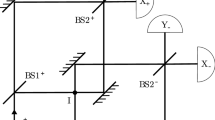Abstract
We consider perspectives of application of coinductive and corecursive methods of non-well-founded mathematics to modern physics, especially to adelic and p-adic quantum mechanics. We also survey perspectives of relationship between modern physics and unconventional computing.
Similar content being viewed by others
References
R. Ackermann, Data, Instruments and Theory (Princeton Univ. Press, Princeton, 1985).
P. Aczel, Non-Well-Founded Sets (Stanford, 1988).
A. Adamatzky, Computing in Nonlinear Media and Automata Collectives (Inst. Phys. Publishing, 2001).
A. Adamatzky, B. De Lacy Costello and T. Asai, Reaction-Diffusion Computers (Elsevier, 2005).
S. Albeverio, A. Yu. Khrennikov and P. Kloeden, “Memory retrieval as a p-adic dynamical system” Biosystems 49, 105–115 (1999).
F. Bartels, “Generalized coinduction” Math. Structures Comput. Sci. 13, 321–348 (2003).
J. Barwise and J. Etchemendy, The Liar (Oxford UP, New York, 1987).
J. Barwise and L. Moss, Vicious Circles (Stanford, 1996).
J. Barwise and L. Moss, Hypersets (Springer Verlag, New York, 1992).
J. Bell, Speakable and Unspeakable in Quantum Mechanics (Cambridge Univ.Press, Cambridge, 1987).
E. Beltrametti and G. Cassinelli, “Quantum mechanics and p-adic numbers,” Found. of Physics 2, 1–7 (1972).
M. Burgin, Super-Recursive Algorithms, Monographs in Computer Science (Springer, 2005).
B. J. Copeland, ”Hypercomputation,” Minds and Machines 12, 461–502 (2002).
P. A. M. Dirac, “The physical interpretation of quantum mechanics,” Proc. Roy. Soc. London A 180, 1–39 (1942).
B. Dragovic, ”On signature change in p-adic space-time,” Mod. Phys. Lett. 6, 2301–2307 (1991).
E. Eberbach and P. Wegner, “Beyond TuringMachines,” Bulletin of the EATCS 81, 279–304 (2003).
A. Hurd and P. A. Loeb, An Introduction to Nonstandard Real Analysis (Academic Press, New York, 1980).
P. Galison, How Experiments End (Univ. of Chicago Press, Chicago, 1987).
R. Gandy, “Church’s Thesis and Principles for Mechanisms,” eds. J. Barwise, H. J. Keisler and K. Kunen, The Kleene Symposium (North-Holland, Amsterdam).
D. Goldin, S. Smolka and P. Wegner, (eds.), Interactive Computation: the New Paradigm (Springer, 2006).
A. D. Gordon, “Bisimilarity as a theory of functional programming,” Theor. Comput. Sci. 228, 5–47 (1999).
B. Jacobs and J. Rutten, “A tutorial on (co)algebras and (co)induction” EATCS Bulletin 62, 222–259 (1997).
A. Yu. Khrennikov, “p-Adic quantum mechanics with p-adic valued functions,” J. Math. Phys. 32(4), 932–937 (1991).
A. Yu. Khrennikov, p-adic valued distributions in mathematical physics (Kluwer Acad. Publishers, Dordrecht, 1994).
A. Yu. Khrennikov, Interpretations of Probability (VSP Int. Sc. Publishers, Utrecht/Tokyo, 1999).
A. Yu. Khrennikov, Non-Archimedian Analysis: Quantum Paradoxes, Dynamical Systems and Biological Models (Kluwer Acad. Publishers, Dordrecht, 1997).
A. Yu. Khrennikov, Information Dynamics in Cognitive, Psychological and Anomalous Phenomena (Kluwer Acad. Publishers, Dordrecht, 2004).
A. Yu. Khrennikov, Modeling of Processes of Thinking in p-Adic Coordinates (Nauka, Fizmatlit, Moscow, 2004) [in Russian].
A. Yu. Khrennikov and A. Schumann, “Logical approach to p-adic probabilities,” Bull. of the Section of Logic 35(1), 49–57 (2006).
N. Koblitz, p-Adic Numbers, p-Adic Analysis and Zeta Functions (Springer-Verlag, 1984).
A. N. Kolmogorov, “Grundbegriffe der Wahrscheinlichkeitsrechnung,” Ergebnisse der Mathematik 2, 1–61 (1933).
A. A. Markov, Theory of Algorithms (Academy of Sciences of the USSR, Moscow, 1954) [in Russian].
K. Morita and K. Imai, Logical Universality and Self-Reproduction in Reversible Cellular Automata (ICES, 1996).
L. Moss, “Parametric Corecursion,” Theor. Comput. Sci 260, 139–164 (2001).
I. Newton, TheMathematical Principles of Natural Philosophy.
D. Pavlović and M. H. Escardó, “Calculus in coinductive form,” in Proc. 13th Annual IEEE Symposium on Logic in Computer Science, pp. 408–417 (1998).
A. Robinson, Non-Standard Analysis (North-Holland Publ. Co., 1966).
A. Schumann, “Non-Archimedean valued sequent logic,” in Eighth International Symposium on Symbolic and Numeric Algorithms for Scientific Computing (SYNASC’06), pp. 89–92 (IEEE Press, 2006).
A. Schumann, “p-Adic multiple-validity and p-adic valued logical calculi,” J. Multiple-Valued Logic and Soft Computing 13(1–2), 29–60 (2007).
A. Schumann, “Non-Archimedean valued predicate logic,” Bull. of the Section of Logic 36(1–2), 67–78 (2007).
A. Schumann, “Non-Archimedean fuzzy reasoning,” in Fuzzy Systems and Knowledge Discovery (FSKD’07), Vol. 1, pp. 2–6 (IEEE Computer Soc. Press, 2007).
A. Schumann, “Non-Archimedean fuzzy and probability logic,” J. Applied Non-Classical Logics 18/1, 29–48 (2008).
A. Schumann, “Non-well-founded probabilities on streams,” SMPS’08, (2008), to appear.
A. A. Siddiqui, M. Akram and E. U. Haque, “Equivalence of completeness axiom and principle of continuous induction,” Science International 13(3), 211–213 (2001).
S. Stepney et al.,“Journeys in non-classical computation I: A grand challenge for computing research,” Parallel Algorithms Appl. 20(1), 5–19 (2005).
S. Stepney et al., “Journeys in non-classical computation II: initial journeys and waypoints,” Parallel Algorithms Appl. 21(2), 97–125 (2006).
E. Thiran, D. Verstegen and J. Weyers, “p-Adic dynamics,” J. Stat. Phys. 54, 893–913 (1989).
V. S. Vladimirov, I. V. Volovich and E. I. Zelenov, p-Adic Analysis and Mathematical Physics (World Scientific, Singapore, 1994).
V. S. Vladimirov and I. V. Volovich, “p-Adic quantum mechanics,” Commun. Math. Phys. 123, 659–676 (1989).
I. V. Volovich, “p-Adic string,” Class. Quant. Grav. 4, 83–87 (1987).
P. Wegner, “Why interaction is more powerful than algorithms,” Commun. ACM 40(5), 89–91 (1997).
Author information
Authors and Affiliations
Corresponding author
Additional information
The text was submitted by the authors in English.
Rights and permissions
About this article
Cite this article
Khrennikov, A., Schumann, A. p-Adic physics, non-well-founded reality and unconventional computing. P-Adic Num Ultrametr Anal Appl 1, 297–306 (2009). https://doi.org/10.1134/S2070046609040037
Received:
Published:
Issue Date:
DOI: https://doi.org/10.1134/S2070046609040037



